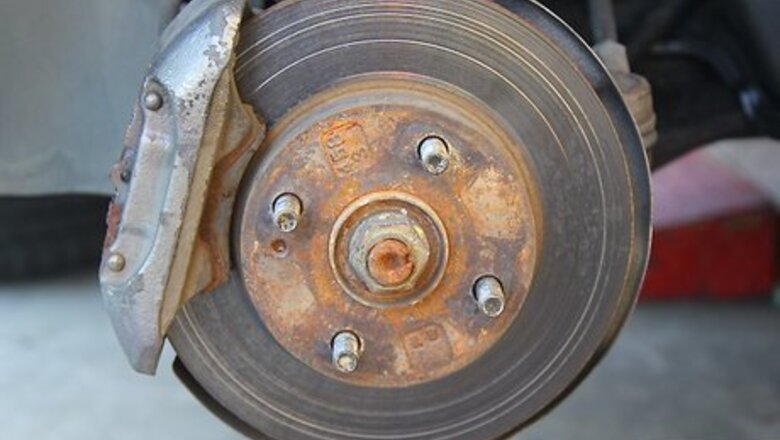
views
Choosing the Right Brake Pads and Brake Shoes

Choose between bonded and riveted friction material. All brakes need to have a softer friction material attached to the stronger metal backing plate. Brake manufacturers use two methods to attach the friction material to the backing plate: bonding with an adhesive or riveting with high strength rivets. There’s no clearly superior method for attaching the friction material, but bonding allows the brakes to last slightly longer because as the friction material wears down, the rivets make contact with the brake rotors or drums and squeal a bit when they’re nearly worn out. By the time you hear the squeal of rivets making contact with the rotors or drums during braking, it’s time to change the brakes anyhow.Choose the Right Brake Pads Step 1Bullet1 Version 2.jpg Bonded brakes wear down to the backing plate which usually ruins your rotors or drums if not changed promptly when the metal to metal grinding sound is heard when applying the brakes.Choose the Right Brake Pads Step 1Bullet2 Version 2.jpg

Think about your driving requirements when choosing a brake pad material. Purchasing replacement brake pads or shoes will require you to make a choice about the material they are made from. At this point, you need to determine how severe your braking needs are. Some things to consider include: How mountainous is your driving? How hot is the climate you live in? What are the traffic patterns you travel in? How tolerant are you to brakes that squeal a bit? Do you pull a trailer behind your vehicle ? Do you have to deal with deep puddles in the winter or rainy season?
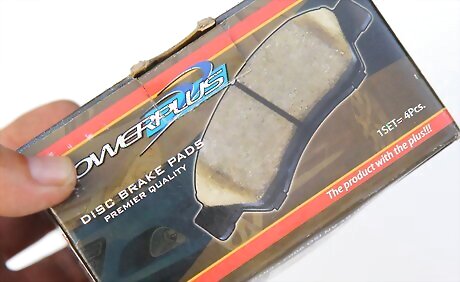
Decide between organic, semi metallic, fully metallic and ceramic break pad materials. Before choosing a brake pad to shoe material, it's important to consider the pros and cons of each. Organic: Some cars come with brakes which are made from an organic material. This provides good life for the other brake components, but don’t offer superior braking when pulling a trailer or traveling long downhill routes. Additionally, organic brake material does lose a lot of braking capacity when they get wet.Choose the Right Brake Pads Step 3Bullet1 Version 2.jpg Semi-metallic: A better braking material is called semi-metallic, in which a composite of soft metals are embedded in the friction material which enhances braking . However, this does wear out the rotors or drums a bit faster than the organic materials.Choose the Right Brake Pads Step 3Bullet2 Version 2.jpg Fully metallic: The next step up in price, quality and braking efficiency is fully metallic brakes which offer great braking in almost any condition, but do wear the rotors/drums faster.Choose the Right Brake Pads Step 3Bullet3 Version 2.jpg Ceramic: These are more expensive than the other 3 choices but do offer the longest life and best warranty. Ceramic brakes tolerate very high temperatures with very little fading or loss of braking when wet. Choose the Right Brake Pads Step 3Bullet4 Version 2.jpg
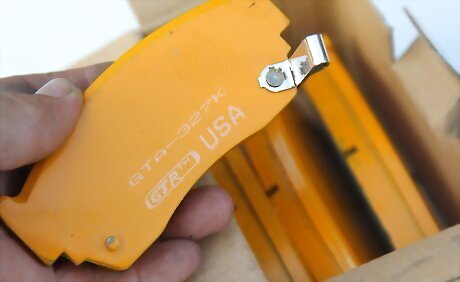
Opt for semi-metallic brake pads for regular driving. Semi-metallic brake pads tend to be a great all-round choice for commuter vehicles, and they’re very reasonably priced. Most newer vehicles come with semi-metallic pads or shoes, as these are what car manufacturers recommends. Even vehicle that have rotors made of harder metals tolerate the semi-metallic pads very well.Choose the Right Brake Pads Step 4Bullet1 Version 2.jpg However, if you regularly use your vehicle for more heavy-duty tasks — such as pulling a trailer up a mountainous path — you may be better off going for higher-end, fully metallic or ceramic brake pads.Choose the Right Brake Pads Step 4Bullet2 Version 2.jpg In other words, you need to seriously consider your regular driving conditions and how much stress will be placed on the breaks when choosing the right brake pad material — it's a matter of safety.Choose the Right Brake Pads Step 4Bullet3 Version 2.jpg

Review the entire break system when replacing the brake pads. It’s always wise to consider the entire brake system when you perform a repair yourself or have it completed by a service shop. The brake pads can be no more effective than the quality of the rotors they contact and the master/slave cylinders that move the pads in and out to perform their functions.Choose the Right Brake Pads Step 5Bullet1 Version 2.jpg It’s also wise to flush the old brake fluid out of the hydraulic system when if the vehicle or truck is over 8 years old just to keep the moisture levels low and brakes working at their peak levels.Choose the Right Brake Pads Step 5Bullet2 Version 2.jpg
Understanding the Mechanics
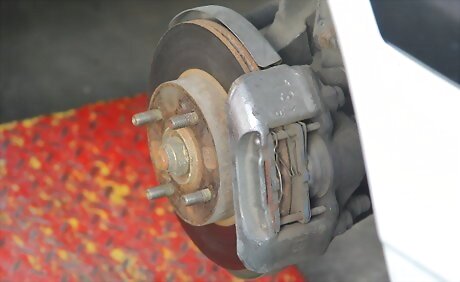
Learn the difference between brake pads and brake shoes. Brake pads and brake shoes are different from one another. The brake pad is built for disc brakes found on most front axles of cars and trucks. Brake shoes, on the other hand, are built for drum brakes which are often found on the back axles of cars and trucks. The reason behind these two different designs can be found by examining the braking sequence: When you actuate the brakes of your vehicle, the disc brake pads or brake shoes have to slow down the brake rotors or drums mounted between tire rims and the suspension. The friction of the disc pads squeezing the rotors or pushing the brake shoes outward on the drums in order to slow the vehicle down causes the disk pads or shoes to get really hot.Choose the Right Brake Pads Step 6Bullet1 Version 2.jpg On long downhill runs, there is a lot more stress placed on the front brakes (and therefore the front brake pads) than on the back brakes. For this reason, a superior braking method is required for the front brakes in order to handle this extra stress.Choose the Right Brake Pads Step 6Bullet2 Version 2.jpg
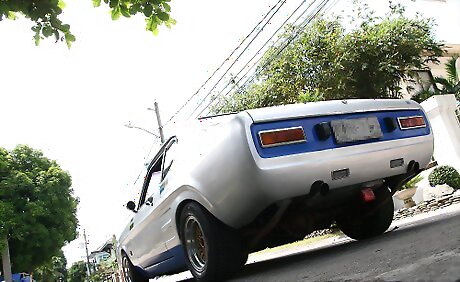
Understand why disc brakes are superior to drum brakes. As mentioned above, the disc brakes located at the front of the vehicle are required to handle more stress than the drum brakes at the rear of the vehicle. As a result, they need to be of a higher quality. Disc brakes were developed by race car and aircraft designers who wanted to find the best way of slowing down the machine without burning up the brake shoes. They were later introduced to the front axles of commercial vehicles in order to reduce the wear-and-tear on the front brakes.Choose the Right Brake Pads Step 7Bullet1 Version 2.jpg The rear axle, on the other hand, doesn't have nearly as much force on it during braking, and since brake drums are cheaper and easier to manufacture, these are the more common form of brakes on the rear of most passenger cars and trucks.Choose the Right Brake Pads Step 7Bullet2 Version 2.jpg However, more modern performance cars and heavy duty trucks usually have disc brakes on both axles (front and rear) because of their superior braking capacity. Disc brakes handle heat a bit better than drum brakes too, which means they still work well when they’re hot. Any braking system can develop fading from heat or water but disc brakes recover from those two issues quicker than drum brakes.Choose the Right Brake Pads Step 7Bullet3 Version 2.jpg

















Comments
0 comment